Why Think Like a Leader?
Think Like a Leader is premised on the idea that how we think about leadership matters. Significantly. Leaders change the world. Ideas transform leaders.
Experience has taught me that people usually have a "default" way they think about leadership - in short, leadership is about being in charge. Much of my leadership consulting, spanning decades, has been helping people escape traps of that default thinking.
Let me be clear. Default or “conventional” ideas about leadership are not wrong. It’s simply that conventional thinking can be quite limiting.
Sharpening your thinking about leadership shines a light on uncommon leadership principles, presenting a framework to help you find and foster your best path to exemplary leadership.
Let’s go!
Think Like A Leader
©2019 Tom Stevens - Think Leadership Ideas
Introduction
Idea 1 - People Mojo
Idea 2 - Distinctive Work
Idea 3 - Living Systems
Idea 4 - Followers
Idea 5 - Empowerment
Idea 6 - Art
Idea 7 - Growth
Summary PDF
Thinking About Thinking
Before getting into ideas about leadership, it’s essential to understand a key concept about “ideas” and about how people “think” in general. As I’ve pointed out in numerous workshops and presentations, “You don’t think like you think you think.”
Most people have the notion, arising out of our culture originating in the Enlightenment era, that thinking flows in a rational, logical way, similar to the way we structure a sentence in language. Words have specific meanings.
Idea Clouds
Ideas, like words, don’t exist in isolation, with precise and tidy meanings. Rather any idea is attached to related ideas, or associations. Ideas exist in “clouds” of related ideas and assumptions. We make sense of the world through clouds of ideas.
These clouds of ideas form the basis of the mental models we have of the world, of the cognitive framework that underpins understanding the world. These mental models, clouds of ideas, shape our deep beliefs, and likewise our deep beliefs shape the ideas we experience.
Without getting into the psychology behind it, let me point out that the acquiring of idea clouds (i.e., mental models, associations, and assumptions) and how idea clouds drive our perception and behavior typically is in large part unconscious, outside of our awareness. Idea clouds present information to our minds far beyond what we may be aware of at any given moment.
A simple example. Imagine if I were to say to a group of people, anywhere in mainstream America, “I went to a baseball game last week.” In all likelihood, everyone would immediately understand what “baseball” means. In order to understand the idea of “baseball” there are several related ideas, an idea cloud, that are also understood without having to think about it:
- the concept of teams;
- the notion of a game, with certain rules, as a contest between teams;
- that in this game a pitcher throws a “ball” that an opposing team player attempts to hit with a “bat”;
- the idea of “bases” and “home” and “safe” and “out”;
- the concepts of keeping score, of winning and losing;
- the concept of athletics, and sports.
[Aside: In addition to the cognitive associations, there also exists emotional associations with all of these ideas. These emotional associations are of great interest as a therapist, or an advertiser, but beyond the present purpose of presenting a way of understanding leadership.]
The Idea Cloud Around “Leadership”
As noted before, I believe there is universal agreement that leadership is important, indispensable, and valued.
Leadership is studied, celebrated, discussed, and experienced (for better or worse) wherever there are human organizations. We are exposed to ideas of leadership through fiction and factual biography, current events and ancient history, inspirational and mundane experience, by intent and happenstance. We consume stories of leadership for professional development, for insight, for inspiration, and for entertainment.
There is an abundance of stories that celebrate the ‘leader’ who is ‘in charge’ and is instrumental for achievement even against great challenges. The president. CEO. Captain. Chief. General. Mayor.
And every day we all have to navigate hierarchical social and power structures.
It is this experience that forms the core of conventional thinking about leadership, and it draws a cloud of related ideas. Succinctly, I would describe the idea cloud of conventional thinking about leadership as follows:
Leadership is about…
- The Leader, and what the leader accomplishes;
- Position. Being in charge. The boss;
- Getting everyone to do their job;
- Keeping the organization running like a well-oiled machine;
- Superiority in your line of work;
- Having the answers (so you can tell people what to do);
- Having good leadership character traits.
Again, none of these “conventional” ideas about leadership are wrong or incorrect. But conventional thinking can be quite limiting.
Think Like a Leader presents seven ideas about leadership, together forming an alternative idea cloud to replace conventional thinking. My experience is that these alternative ideas are more likely to foster extraordinary leadership, particularly in the 21st century world. Briefly outlined:
Leadership is….
- People Working Together to Achieve Outcomes;
- A Distinctive Kind of Work;
- Engaging Endeavors (Organizations) as Living Systems;
- Gaining Followers (more than acquiring Power);
- Empowerment requires more leadership (not less);
- An ART unique to each individual;
- a practice that anyone can improve.
Think Like A Leader - Idea 1
Leadership is the Mojo for People to Achieve Outcomes
Why bother with Leadership?
Thought experiment: imagine asking 100 people, “is leadership important?”
I would be surprised if the response wasn’t a 100% resounding “YES - of course leadership is important!”
So how come? Why is leadership so important?
Leadership is significant not because it’s a noble thing to do. Or that it advances your career or status.
Rather, it is important because it’s an essential component of making any endeavor effective at achieving outcomes.
By ENDEAVOR I mean a business, a cause, an enterprise, an organization, a project, a club, a venture - any effort that requires more than one human working together to achieve outcomes - no matter how formal or informal its structure.
Here is a simple model for thinking about endeavors: people engage in work to produce outcomes:
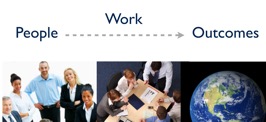
It’s the human element that makes leadership necessary in endeavors. Humans, unlike inanimate objects like furniture or automobiles, have a mind of their own. Put a chair in a room, it will dependably stay put until you move it elsewhere. My automobile needs steering, but it does not require an iota of leadership to function.
People, on the other hand, have independent minds, intention, and creative capacity. Indeed, it is just these qualities that make the “work” that people could do for an endeavor so valuable - especially any activity that requires knowledge and judgement. Conversely, it is also these qualities that make people working together unpredictable, exasperating, and complicated.
Leadership is valuable because it (1) helps to assure that outcomes will be achieved, and (2) increases effectiveness and efficiency in how outcomes are achieved.
Leadership is what makes exceptional endeavors rock.
Conventional Thinking: Leadership is about being in charge; Leadership is a step in personal achievement.
Think Like a Leader: Leadership is the Mojo for People to Achieve Outcomes.
To be continued in the next idea….. “Leadership" is a distinct kind of work.
Think Like A Leader - Idea 2
Leadership is a Distinctive Kind of Work
Any endeavor (i.e., business, agency, club, enterprise, association, cause, etc.) can be thought of as people doing work to achieve outcomes.
Expanding on this simple model, the work of an endeavor falls into three categories.
The first is the endeavor’s core work - what the endeavor seeks to accomplish. For an airline it’s flying passengers. For a restaurant it’s preparing and serving food. If you have a plumbing business, it’s installing or fixing pipes so fluids can move from one place to another.
A second component is the endeavor's business work. How does money flow in and out, bills get paid, supplies ordered, employees hired, vendors selected, customers acquired, funds raised, volunteers recruited, etc. Here the word ‘business’ covers the larger sense of all the administration and logistics needed to operate, whether or not the endeavor is a commercial or social enterprise.
Leadership is a third component - one that is distinct from an endeavor’s core work or its business processes. And it’s leadership that adds the mojo, that can exponentially increase the effectiveness of the effort that people make to advance the endeavor.
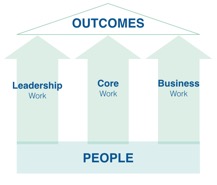
What constitutes the Work of Leadership?
The key priorities for the work of leadership include direction (why does the endeavor exist and what is the strategy for achieving outcomes), performance (how effectively is all work getting done), and innovation (what needs to change to create new dimensions of performance).
And how do leaders get this stuff done? Other than doing work themselves, they establish structure and cultivate culture.
These five priorities of leadership - direction, performance, innovation, structure, and culture - apply to endeavors of every size and in every sector; business, non-profit, public, academic, grass-roots, you name it.
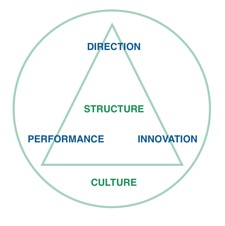
Conventional Thinking: Excel by becoming the best in your industry or profession. Excel by flawless business execution. Leadership development is a luxury when we have the time and resources.
Think Like a Leader: Leadership is a distinctive kind of work, and may be the best investment for an endeavor to excel.
To be continued in the next idea….. Leaders Engage Endeavors as Living Systems.
Think Like A Leader - Idea 3
Leaders Engage Endeavors as Living Systems
The machine continues to be the dominant metaphor in organizations. And because of this, would-be leaders easily become trapped in what I call “job” mentality, that everything would be fine if everyone just did their job.
We have plenty of experiences each day that reinforce this perception of life-as-machine: we step on the gas pedal and our cars move. We push a button and documents get efficiently copied – maybe even on both sides, collated, and stapled. We understand systems that operate in a machine-like way, i.e., order a widget on Amazon Prime and two days later it arrives on your doorstep.
Similarly, I continue to be approached by aspiring leaders looking for that metaphorical lever, pedal, dial, or button that will motivate people, get them to change, or increase morale. It’s the wrong thing to be looking for because it’s the wrong metaphor - because living systems are different from mechanical systems.
You operate your car. You don’t operate your dog.
Rather, you approach your dog as a living organism that you engage and seek to influence with various practices. It’s also a two-way street. If that’s true for your dog, think how even more true it is when dealing with people. Remember, our endeavors (business, agency, club, enterprise, association, etc.) can be thought of as people doing work to achieve outcomes. The core and business work of the endeavor might best be organized like a machine, but dealing with people requires competency in influencing living systems. This is why leadership is a distinctive kind of work.
When it comes to living systems, think cultivate like a garden, not operate like a machine. There are no magic levers or buttons for aligning personal and organizational goals, establishing the right structure, increasing interpersonal competencies, and attending to the organization’s culture. But just as there are plenty of practices that influence the health and life of a garden, there are endless practices that can tremendously influence the level of performance people contribute to an endeavor. It’s understanding these practices that are the heart of learning leadership.
People are not machines. Endeavors that rely on the creativity and thinking of people working together need to be treated as living systems. Being a leader is different from being a boss.
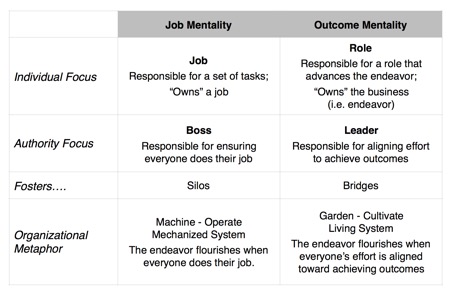
Conventional Thinking: Get everyone to do their job, clarify what are the jobs to do. Operate.
Think Like a Leader: Engage people to achieve common outcomes, clarify the outcomes to be achieved. Cultivate.
To be continued in the next idea….. Followers, Not Power, Define Acts of Leadership.
Think Like A Leader - Idea 4
Followers, Not Power, Define Acts of Leadership
The conventional notion of a leader refers to the person in charge, the head of an endeavor, the boss, the captain, the person who tells others what to do. In this way of thinking, an act of leadership is something the leader does - i.e., command or decide.
I don’t subscribe to the conventional notion. (...but you already knew that!)
I think “acts of leadership” are ultimately determined by followers not leaders. Willing followers.
Leaders initiate action - but it’s how someone responds that counts. Real leadership is about circumstances when the way forward is unclear, and people are ‘empowered’ to follow...or not. Like we find in many complex community endeavors.
Regardless of the circumstances, when people “follow” because they are compelled to do so, they are simply complying with coercion. Sometimes, of course, this may be necessary (for example, in emergencies) but it’s not a formula for bringing out the best talent.
When people follow what those in authority say because it’s simply within the bounds of the ‘script’ of their mutual relationship - what French and Raven would call legitimate use of power - these are acts of management.
But in circumstances where the way forward is not clear, someone has to initiate an action. When that action is willingly followed - i.e., the follower has the power to say no as well as yes - an act of leadership is completed.
I distinguish leadership from management in the following way: management is organizing resources and people to accomplish pre-established goals when the way forward is generally known and understood; leadership is gaining willing followers when the way forward is unclear.
Power indeed exists, can’t be completely severed from human endeavors, and is something aspiring leaders need to understand and use wisely. But what constitutes the highest form of leadership is grounded in empowerment - in people choosing to follow when way forward is unclear or unknown.
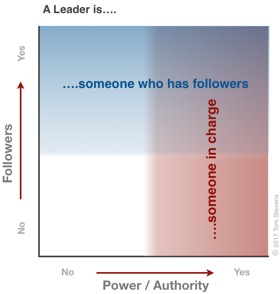
Great video: Leadership Lessons from a Dancing Guy
Conventional Thinking: A Leader is someone who is in charge.
Think Like a Leader: A Leader is someone who has followers.
To be continued in the next idea….. Empowerment Requires More Leadership (Not Less).
Think Like A Leader - Idea 5
Empowerment Requires More Leadership (Not Less)
The conventional notion of a leader refers to the person in charge, the one who tells others what to do, the one who decides. So in this way of thinking it naturally follows that allowing people to make their own decisions - empowering them - reduces if not eliminates the need for a leader.
Of course, this way of thinking is a set-up for problems if not outright failure. Acknowledging a continuum of empowerment - that it’s not all or nothing - doesn’t resolve the issue: what’s the value of leadership if it’s not telling people what to do?
Especially for creative tasks, it’s well demonstrated** that people contribute their best when empowered. That said, experience will indicate that people acting without leadership are not likely to accomplish anything, at least not together.
Back to previous ideas discussed in this series, leadership is a distinctive kind of work, the mojo for people to achieve outcomes in their endeavors. The distinction between thinking of leadership as a distinctive kind of work vs. thinking of leadership as being in charge is significant because it gets to the heart of what makes leadership valuable - achieving outcomes.
The work of leadership - articulating direction, measuring performance, initiating innovation, establishing structure, and encouraging culture - becomes more important precisely because it’s a prerequisite for making the core and business work of empowered people mean something. Note that it’s not about who does the work of leadership - designated ‘leaders’ or otherwise - rather that the work of leadership receives needed attention.
Individuals can be empowered for autonomy in their actions, but it is leadership that aligns people to a common direction. Empowerment lets people take responsibility for performance and innovation, but it is leadership that gets people on the same page.
The more complex the circumstances, the more diverse the players, and the more empowered people are to choose their own course of action, then the more important artful leadership becomes for people to follow a course of action together.
Conventional Thinking: If a Leader is someone is in charge, empowering people means leaders aren’t necessary.
Think Like a Leader: The more people are empowered, the more leadership is needed for achievement.
To be continued in the next idea….. Leadership is the Multidimensional Art of Being a Leader.
Think Like A Leader - Idea 6
Leadership is the ART of Being a Leader
Consider Rodin’s iconic sculpture, The Thinker...or any other sculpture you might fancy.
A few written sentences or a photo about it may be informative, but nothing compared to actually seeing the sculpture in all three dimensions, in an apposite setting, and knowing something of its place in the history of art and culture.
In the same way a great sculpture is best appreciated in 3 dimensions plus place and history, our understanding of leadership is enhanced when we recognize five dimensions of leadership practice - character, role, relationships, context, and story.
This wholistic view of leadership informs us about the practice of leadership. It is the endless variety in which individuals can creatively apply these five ‘dimensions’ of leadership practice that make leadership an “art” more than a science.
Character - your personality, knowledge, talents, preferences - in short, who you are.
Role - your position, function, profession; your “place” in an endeavor.
Relationships - your behaviors, skills, and interactions that involve others.
Context - the endeavor and the larger ecosystem in which the endeavor resides.
Story - the narrative; the impact, the meaning of how characters, roles, actions, and endeavors unfold over time.
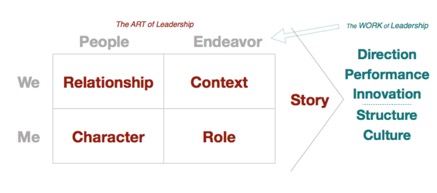
Conventional Thinking: Leadership is about fostering certain character traits (e.g.,charisma, vision, likability, etc.).
Think Like a Leader: Leadership in practice is a multidimensional art.
To be continued in the next idea….. Anyone Can Up Their Leadership Game.
Think Like A Leader - Idea 7
Anyone Can Up Their Leadership Game
One of the most common questions I’m asked as a leadership expert is, “do you think leaders are born or made?”
The question itself exemplifies a common thinking error - i.e., it presumes an “either-or” answer.
So my answer to the question is simply, yes.
Yes, leaders are born - in that we all have differing inherent talents. Sometimes people are lucky that their natural talent corresponds nicely with leadership challenges and opportunities they encounter.
Yes, leaders are made. Here’s why….
Inherent talent is no guarantee of performance, in leadership or anything else. Having an inborn talent for art, or music, or golf, or medicine, or plumbing does not translate into performance in those endeavors without “learning” the specifics of the art, sport, or profession. Research has shown high performance is more a factor of intentional practice and feedback than inherent talent.
If one has natural talent for leadership, terrific. One still has to develop the talent, just as one does in art, music, golf, medicine, or plumbing.
And for those who’s talents lay elsewhere, but who are called upon to contribute to the work of leadership...there are many skill-sets that are quite learnable that can advance one’s practice of the art of leadership.
Referring back to our 5 Dimensions Art of Leadership model, anyone - I repeat, anyone, regardless of their inherent talent - can find one or more dimension to dramatically increase their leadership competency:
- by understanding of their own character and leveraging their strengths;
- by cultivating influence through one’s role in an endeavor;
- by systematically contributing to getting the leadership work done in an endeavor, in a way that is relevant to its context;
- by developing interpersonal relationship skill-sets (negotiation, communication, networking, speaking, facilitation, meeting management, etc.) to work with others to advance the endeavor;
- applying the preceding efforts consistently, congruently, and coherently in a way that creates a story that has meaning.
Leaders may be born. They are always made.
…..So what are YOU going to do to accelerate your practice of leadership?
Conventional Thinking: Great leaders are born with traits that make for good leadership.
Think Like a Leader: Anyone can significantly up their leadership game.
Here’s a link to a 2 page summary of the 7 ideas covered in Think Like A Leader
Think Like A Leader Handout